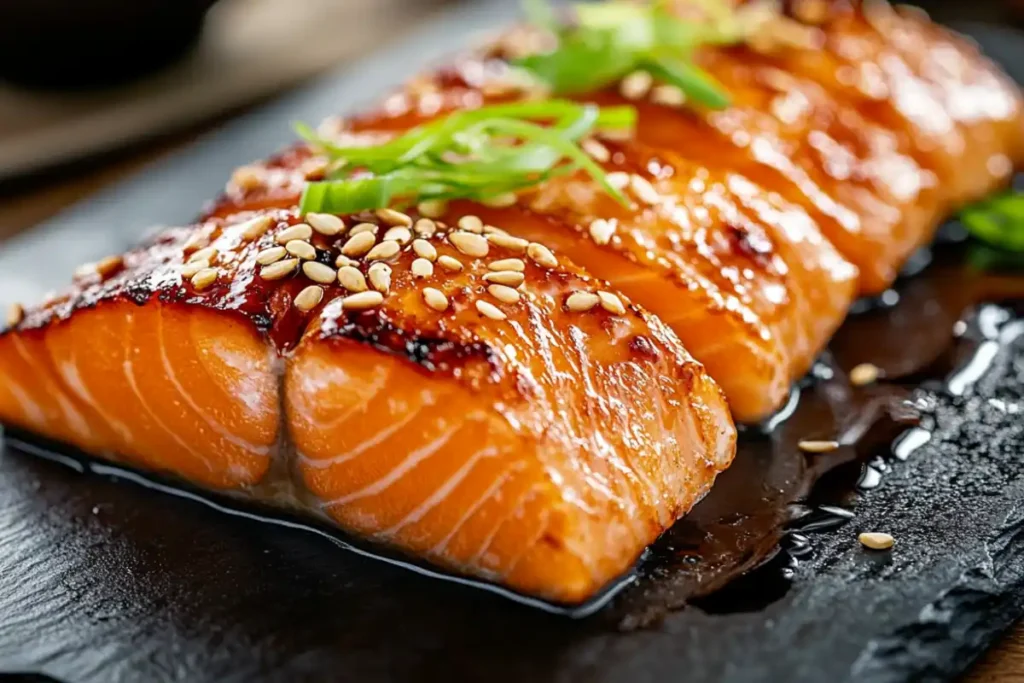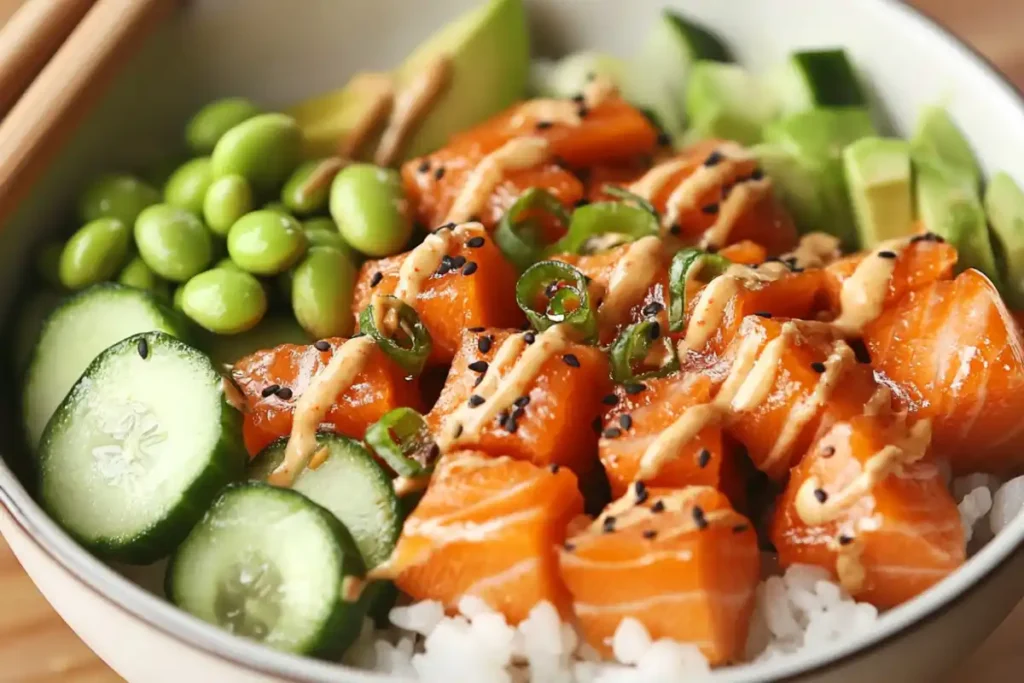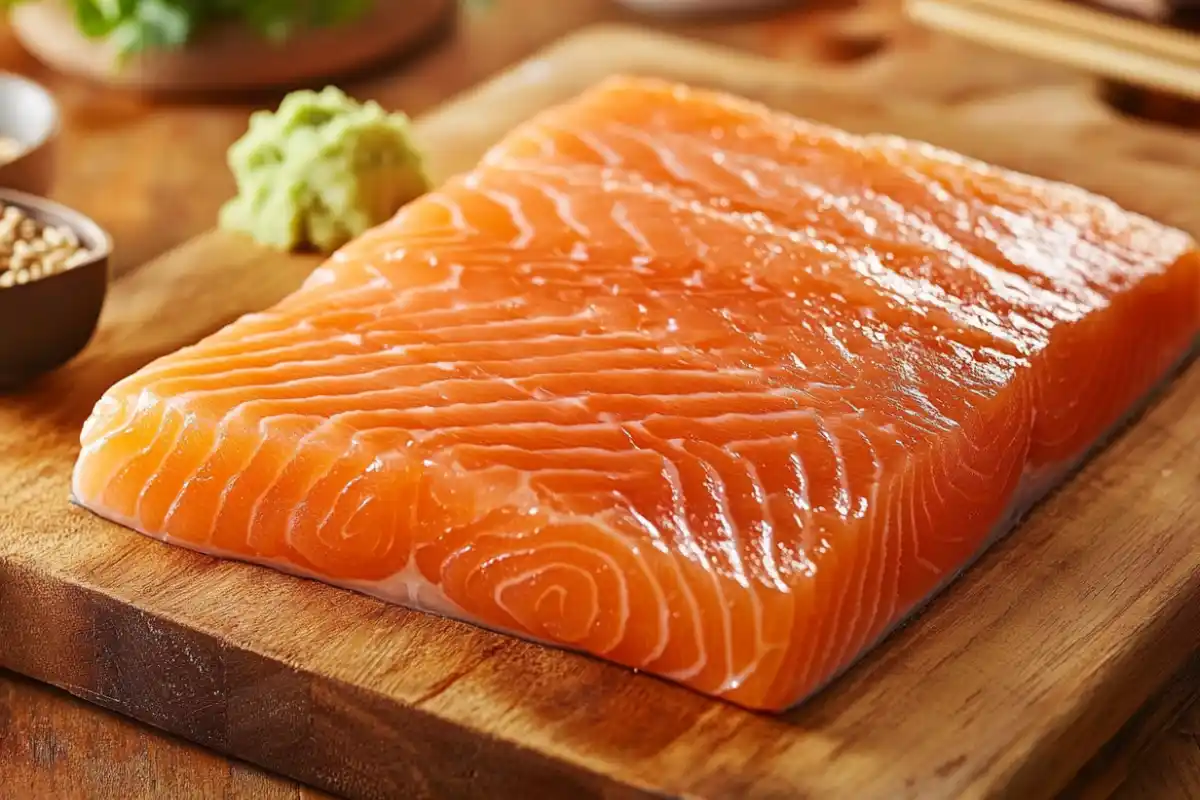Sushi-grade salmon is often associated with delicate sashimi slices, vibrant poke bowls, and perfectly rolled sushi. But what if you want to cook sushi-grade salmon? Is it safe? Does it change the flavor or texture? And most importantly, is it worth it?
In this guide, we’ll dive deep into what makes salmon sushi-grade, whether it’s a good idea to cook it, and the best methods if you decide to do so. We’ll also cover food safety, storage tips, and some delicious recipes. By the end, you’ll know exactly how to handle, prepare, and cook sushi-grade salmon like a pro!
Understanding Sushi-Grade Salmon
What Does “Sushi Grade” Mean?
The term sushi-grade isn’t an official certification but rather a marketing label used by fish vendors. It generally means the fish is of high quality and has been processed to minimize health risks. The most important factor? Freezing.
According to the FDA, fish intended for raw consumption must be blast frozen at -31°F (-35°C) or frozen and stored at -4°F (-20°C) for at least 7 days. This process kills parasites, making the fish safer to eat raw.
However, not all sushi-grade salmon is created equal. Farmed salmon is often safer for raw consumption than wild-caught salmon because it’s raised in controlled environments with minimal exposure to parasites.
How Is Sushi-Grade Salmon Different From Regular Salmon?
You might wonder—why not just use any salmon for sushi? The answer lies in safety, quality, and freshness:
- Sushi-grade salmon is frozen properly – Unlike regular salmon, which may carry parasites, sushi-grade salmon undergoes deep freezing to kill any potential risks.
- It’s handled with extra care – From the moment it’s caught, sushi-grade salmon is processed with raw consumption in mind. That means cleaner handling, temperature control, and faster delivery to maintain freshness.
- Higher fat content – Many sushi-grade salmon cuts come from high-fat parts of the fish, making them ideal for raw dishes due to their buttery texture.
Is Sushi-Grade Salmon Safe to Eat Raw?
Yes—as long as it’s truly sushi-grade! But even then, safety precautions are necessary.
- Check for clear labeling – If you’re buying salmon for raw consumption, ensure the packaging explicitly states sushi-grade or sashimi-grade.
- Buy from a trusted source – Reputable fish markets, Japanese grocery stores, and high-end supermarkets are your best bet.
- Use your senses – Sushi-grade salmon should be vibrant in color, firm to the touch, and have a clean, ocean-like smell. If it smells overly fishy or has a slimy texture, toss it out!
- Keep it cold – Always store sushi-grade salmon in the fridge at or below 40°F (4°C) and consume it within a day or two for maximum freshness.
Can You Cook Sushi-Grade Salmon?
Yes, You Can—But Should You?
So, can you cook sushi-grade salmon? Absolutely! But whether you should is another question. Since sushi-grade salmon is selected and handled with raw consumption in mind, cooking it is a matter of preference rather than necessity.
Unlike regular salmon, which often requires thorough cooking to eliminate health risks, sushi-grade salmon has already been frozen to kill parasites. This makes it safe to eat raw, but it doesn’t mean it has to be eaten that way. Cooking it can bring out new flavors and textures that some people prefer.
Does Cooking Change the Quality of Sushi-Grade Salmon?
Yes—but not necessarily for the worse! When cooked, sushi-grade salmon loses some of its delicate, buttery texture. However, it also develops richer flavors and a firmer bite, especially when grilled or seared.
Here’s what happens when you cook sushi-grade salmon:
- Moisture loss – Cooking removes some of the natural oils that make sushi-grade salmon silky smooth.
- Flavor intensification – The natural umami taste deepens, especially when using high-heat methods like searing.
- Texture transformation – The soft, melt-in-your-mouth feel becomes firmer, making it more like traditionally cooked salmon.
Best Cooking Methods for Sushi-Grade Salmon
If you decide to cook sushi-grade salmon, it’s best to use techniques that preserve its tenderness and rich taste. Here are a few top methods:
- Searing (Tataki style) – Lightly searing sushi-grade salmon on high heat enhances its umami while keeping the inside rare.
- Grilling – Adds a smoky flavor while maintaining a flaky texture.
- Baking – A gentle cooking method that preserves moisture.
- Sous Vide – Ensures even cooking without drying it out.
So, if you’ve ever wondered, can you cook sushi-grade salmon?—the answer is yes! But the real magic happens when you use the right cooking technique. Now, let’s explore the best methods in more detail.
Best Ways to Cook Sushi-Grade Salmon )
Searing: The Tataki Method
If you want to cook sushi-grade salmon without losing its raw essence, searing is the way to go. The tataki method involves briefly searing the fish at high heat while leaving the inside mostly raw.

How to do it:
- Heat a cast-iron skillet over high heat.
- Lightly season the salmon with salt, pepper, and sesame oil.
- Sear each side for 10-15 seconds until a golden crust forms.
- Slice thinly and serve with ponzu sauce, soy sauce, or wasabi.
Grilling for a Smoky Flavor
Grilling adds a delicious charred aroma to sushi-grade salmon while keeping it moist inside.
How to grill sushi-grade salmon:
- Preheat the grill to medium-high heat.
- Brush the salmon with olive oil, lemon juice, and a pinch of salt.
- Grill for 2-3 minutes per side until lightly browned.
- Serve with a fresh salad or over rice.
Baking for a Tender Texture
Baking is a low-maintenance way to cook sushi-grade salmon while keeping it juicy.
How to bake sushi-grade salmon:
- Preheat the oven to 375°F (190°C).
- Place the salmon on a lined baking sheet and season with garlic, butter, and herbs.
- Bake for 12-15 minutes or until it reaches your preferred doneness.
- Pair with roasted vegetables or a light sauce.
Sous Vide for Precision Cooking
Sous vide is perfect if you want an evenly cooked, ultra-tender salmon.
How to sous vide sushi-grade salmon:
- Set your sous vide machine to 125°F (52°C).
- Place the salmon in a vacuum-sealed bag with butter, dill, and lemon slices.
- Cook for 30-45 minutes.
- Finish with a quick sear for a crispy edge.
Broiling for a Crisp Outer Layer
Broiling sushi-grade salmon gives it a slightly crispy crust while keeping the inside moist.
How to broil sushi-grade salmon:
- Preheat the oven broiler.
- Place salmon on a baking sheet and brush with teriyaki or honey glaze.
- Broil for 3-5 minutes until caramelized.
- Serve over steamed rice or a grain bowl.
Raw vs. Cooked: Which Is Better?
Flavor & Texture Differences
The biggest difference between raw and cooked sushi-grade salmon is its texture and taste. Raw salmon is buttery, tender, and melts in your mouth. This is why it’s commonly used in sashimi, poke bowls, and sushi rolls.
On the other hand, cooked sushi-grade salmon develops a firmer texture and deeper flavors, especially when grilled or baked. It loses some of its natural silkiness, but it gains smoky, umami-rich notes depending on the cooking method used.
So, if you prefer a silky, delicate taste, raw sushi-grade salmon is the way to go. But if you love bold, savory flavors, cooking it might be a better choice.
Nutritional Differences Between Raw and Cooked Salmon
Nutritionally, both raw and cooked sushi-grade salmon are packed with protein, omega-3 fatty acids, and essential vitamins. However, cooking can slightly alter its nutritional profile.
- Raw salmon retains all its natural omega-3s and vitamins but may carry a higher risk of bacteria if not stored properly.
- Cooked salmon is easier to digest and safer for those with weaker immune systems, but high-heat cooking can reduce some nutrients, like B vitamins and omega-3s.
Best Dishes for Each Style
Some dishes work best with raw sushi-grade salmon, while others shine when it’s cooked.
- Best raw salmon dishes:
- Sushi & sashimi
- Poke bowls
- Carpaccio or tartare
- Best cooked salmon dishes:
- Seared tataki
- Grilled or baked salmon
- Miso-glazed salmon
So, can you cook sushi-grade salmon? Yes! But whether you should keep it raw or cook it depends entirely on your taste and preference.
Food Safety and Handling Sushi-Grade Salmon
How to Properly Store Sushi-Grade Salmon
Storage is key when dealing with sushi-grade salmon. Because it’s meant for raw consumption, proper refrigeration and freezing are essential to prevent spoilage and bacterial growth.
- Refrigerate at or below 40°F (4°C) if you plan to eat it within a day or two.
- Freeze at -4°F (-20°C) or lower if you won’t be using it immediately. This ensures any potential parasites are eliminated.
- Wrap tightly in plastic or vacuum-seal to prevent freezer burn and contamination.
How to Tell if Sushi-Grade Salmon Is Safe to Eat Raw
Even though sushi-grade salmon is processed to be safer for raw consumption, you should still inspect it before eating. Here’s how to tell if it’s fresh and safe:
- Color: Should be a vibrant orange or pink, never dull or gray.
- Smell: Fresh salmon should have a mild ocean scent—if it smells overly fishy, it’s likely bad.
- Texture: It should feel firm and slightly springy, not mushy or slimy.
- Packaging date: Always check the label for freshness and best-by dates.
Precautions When Cooking Sushi-Grade Salmon
If you decide to cook your sushi-grade salmon, follow these safety tips:
- Use a clean cutting board and knife to avoid cross-contamination.
- Cook to an internal temperature of 125°F to 145°F (52°C to 63°C) if you want it fully cooked.
- Avoid overcooking, as it can dry out the delicate texture.
Handling sushi-grade salmon properly ensures that whether raw or cooked, it’s safe and delicious.
Delicious Recipes Using Sushi-Grade Salmon
If you’re looking for tasty ways to enjoy sushi-grade salmon, whether raw or cooked, these recipes will bring out its best flavors. Whether you prefer a light sear, a poke bowl, or a flavorful miso glaze, there’s something for everyone!
Seared Sushi-Grade Salmon with Ponzu Sauce
This quick and easy dish keeps the salmon mostly raw while adding a delicious seared crust.
Ingredients:
- 1 sushi-grade salmon fillet
- 1 tbsp sesame oil
- 1 tbsp soy sauce
- 1 tbsp ponzu sauce
- 1 tsp sesame seeds
- 1 green onion, chopped
Instructions:
- Heat sesame oil in a pan over high heat.
- Sear the salmon for 10-15 seconds on each side until golden brown.
- Slice thinly and drizzle with soy sauce and ponzu.
- Sprinkle sesame seeds and green onions on top. Serve immediately!
Sushi-Grade Salmon Poke Bowl
A refreshing, nutrient-packed dish that’s perfect for a quick meal.
Ingredients:
- 1 sushi-grade salmon fillet, cubed
- 1 cup cooked sushi rice
- 1 tbsp soy sauce
- 1 tsp sesame oil
- ½ avocado, sliced
- ¼ cup cucumber, diced
- 1 tbsp spicy mayo
- 1 tsp furikake seasoning
Instructions:
- Toss cubed salmon with soy sauce and sesame oil.
- Arrange sushi rice in a bowl and top with salmon, avocado, and cucumber.
- Drizzle with spicy mayo and sprinkle furikake seasoning. Enjoy!

Miso-Glazed Sushi-Grade Salmon
For those wondering, can you cook sushi grade salmon?—this baked miso-glazed version is a great choice.
Ingredients:
- 1 sushi-grade salmon fillet
- 2 tbsp miso paste
- 1 tbsp honey
- 1 tbsp soy sauce
- 1 tsp rice vinegar
Instructions:
- Preheat oven to 375°F (190°C).
- Mix miso paste, honey, soy sauce, and rice vinegar in a bowl.
- Coat salmon with the mixture and bake for 12-15 minutes.
- Serve with steamed rice or roasted vegetables.
FAQs
1. Can you cook sushi-grade salmon for sushi rolls?
Yes! While sushi-grade salmon is commonly eaten raw, you can lightly sear or bake it before using it in sushi rolls. It adds a smoky depth of flavor while keeping the inside tender.
2. Is sushi-grade salmon healthier raw or cooked?
Both raw and cooked sushi-grade salmon are rich in omega-3s, protein, and essential nutrients. However, raw salmon retains more heat-sensitive vitamins, while cooking eliminates potential bacteria. It depends on your dietary needs and personal preference!
3. How do you know if salmon is truly sushi-grade?
Sushi-grade salmon should be frozen according to FDA guidelines, handled carefully, and labeled explicitly as sushi-grade or sashimi-grade. Always buy from a trusted source and check for vibrant color, firm texture, and a fresh ocean-like scent.
4. What happens if you cook sushi-grade salmon too much?
Overcooking sushi-grade salmon can make it dry and tough, losing its signature buttery texture. To avoid this, use gentle cooking methods like baking at lower temperatures, quick searing, or sous vide cooking to keep it moist and flavorful.
Conclusion
So, can you cook sushi-grade salmon? The answer is yes—but whether you should depends on your taste and cooking style. Sushi-grade salmon is specially prepared for raw consumption, but when cooked correctly, it can still be incredibly flavorful and tender.
If you love the silky, melt-in-your-mouth texture, keeping it raw in sushi, sashimi, or poke bowls is the way to go. However, if you enjoy rich, smoky flavors and firmer textures, searing, grilling, or baking your sushi-grade salmon can bring out its natural umami. Just be sure to use gentle cooking techniques to preserve its delicate qualities.
No matter how you prepare it, proper handling, storage, and sourcing are crucial. Always buy sushi-grade salmon from a trusted source, store it properly, and follow safety guidelines.
Now that you have a complete guide on sushi-grade salmon—raw and cooked—it’s time to experiment in the kitchen! Whether you’re making a crispy-seared tataki, a comforting miso-glazed fillet, or a refreshing poke bowl, enjoy every bite of this versatile, high-quality fish.
